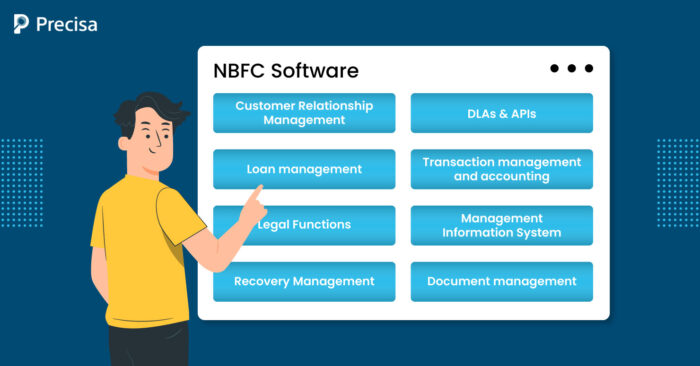The Benefits Of Using NBFC Software For Financial Management

Non-banking Financial Companies (NBFCs) are integral to the financial system. Their contribution to financial inclusion initiatives, dissemination of timely credit to the Micro, Small and Medium Enterprises (MSMEs) and infrastructure development projects are all significant chapters in the story of India’s thriving digital economy.
As of October last year, India has 9500 registered NBFCs with a total asset size of Rs.42.05 lakh crores. In 2021, their credit contribution to the economy was 13.7% of GDP.
This growth is made possible using technology-based business models and fintech solutions that helped NBFCs reach out to the heterogenous customer segments in India.
NBFC software is one such fintech solution that leverages innovative technologies like Artificial Intelligence (AI) and Machine Learning (ML) to streamline workflow and achieve operational efficiency at lower costs.
This blog post examines the benefits of using NBFC software for financial management.
NBFC Software and Its Components: An Overview
An NBFC software is a comprehensive loan management application that automates the end-to-end lending procedures of an NBFC organisation. It must support the front-end and back-office functions related to all loan types in the firm’s portfolio.
Ideally, NBFC software must have certain modules to support the following functions. For example:
-
Customer Relationship Management (CRM)
The CRM handles the whole customer journey during the loan’s life cycle, from the initial interaction with the client to the delivery of the loan closure communication to the borrower and beyond.
Additionally, the module provides a database of customer information to ensure seamless and efficient interactions with the customer. CRM modules must also include client communication and complaint resolution functions.
-
Digital lending apps (DLAs) and Application Programming Interfaces (APIs)
DLAs are mobile or web-based ‘touchpoints’ for facilitating credit services. API integration with third-party applications allows NBFC software to instantly gather required data from different sources.
For instance, getting a credit score or doing KYC verifications becomes easier using integrations with CIBIL and UIDAI.
-
Loan management
This is the core module of the software. This includes loan origination, customer profiling and KYC, document verification, credit appraisal, loan approval, onboarding, loan documentation, disbursement, etc.
-
Transaction management and accounting
Handles the bookkeeping of loans. The accounting module must handle the disbursements, EMI modifications as per the amortisation schedule, application of interest, fees, charges, waivers, etc.
-
Legal functions
Loan agreements have legal ramifications. Therefore, NBFC software should have features to handle the legal specifics. Lenders may opt for legal recourse in cases of delinquent loans.
In such cases, specific steps must be followed, starting with sending a recall notice to the defaulter. All of these details should be supported in the legal module.
-
Management Information System (MIS) and reporting framework
MIS provides actionable business intelligence for decision-making. It must generate concise and detailed reports to assist management and administrative decisions.
Authorities and regulators also need routine reports and specific information regarding the firm’s lending operation. The NBFC software is sufficiently customisable to produce the necessary reports.
-
Recovery Management
Loan recovery is a function that directly affects the profitability of NBFC. It manages automated recovery modes like Electronic Clearing Services (ECS), post-dated checks, bank credits, API interface with collection agents, etc.
This module includes tracking repayments, sending reminders to the borrowers on missed EMIs, and classifying the loan as standard or sub-standard assets based on recovery.
-
Document management
NBFC software simplifies documents and records management. E-documents completely eliminate the issues of lost documents and make it easy to track pending documents.
Document analysis and loan underwriting is simplified with automated document parsing. Advanced document management systems have features for an auto-refresh of customer data rather than seeking manual updates. For example, they can gather customers’ monthly bank account statements using API integration.
5 Advantages of Using NBFC Software
Let’s look at some of the major benefits of NBFC software:
-
Enhanced customer experience through seamless coordination of lending functions
NBFC software’s customer-facing applications/websites are incredibly user-friendly. They are easily accessible on different device platforms, allowing loan applicants to navigate the procedures and documentation with minimal employee assistance effortlessly. This makes the taxing credit availing process manageable for them.
- Improved transparency and security
NBFC lending platforms are designed to meet regulatory requirements on disclosure of terms and conditions to customers. Thanks to Robotic Process Automation (RPA), customers can check all details about the loan, from their eligibility to the nuanced legal terms and conditions.
There are features to protect data confidentiality. Most NBFC software uses cloud-based data storage with high-level encryption and can only be accessed with proper credentials, with audit trails for each access.
- Reduced costs, improved efficiency
One significant advantage of NBFC software is that it improves operational efficiency while lowering operating costs. Back-end automation reduces staff engagement and shortens the credit process’s turnaround time (TAT). RPA also aids in the reduction of costs associated with errors.
Smartphone-based lending apps enable NBFCs to ahold marginalised retail consumers who would otherwise be out of their reach, allowing them to scale their businesses at low costs.
- Options for customisation
NBFCs are now subject to significantly more regulatory changes than ever before. They require agile software to absorb these changes without interrupting current operating conditions.
NBFC software also allows for the expansion of business portfolios by adding new loan types.
- In compliance with the regulator’s directives
The Reserve Bank of India’s (RBI) Master Direction – Information Technology Framework for the NBFC Sector governs the IT framework of NBFCs.
RBI has now directed that all middle- and upper-layer NBFCs deploy Core Financial Services Solutions (CFSS) by September 2025. NBFC software adheres to the RBI rules more closely than off-the-shelf financial management systems.
In Summary
NBFCs in India were slower to adopt technology solutions than mainstream banks for a variety of reasons. In recent years, NBFCs have faced competition not only from banks but also from fintech firms.
Increasing competition and emerging business models like co-lending necessitate that these firms upgrade their IT infrastructure with NBFC software that takes advantage of the new-age technologies.
Integrate your NBFC software with Precisa’s API for fetching bank account statements for credit appraisals. We offer a cloud-based solution for tracking transactions integrated with data analytics for banks, insurance companies and NBFCs.
Our bank statement analyser provides custom reports on irregularities, bounce cheque details, return charges, fees, transaction patterns and more.
Sign in to check out our products.

